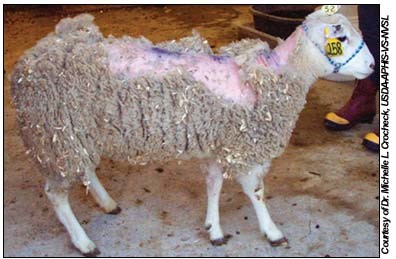Scrapie is a fatal, degenerative disease affecting the central nervous system of sheep and goats and is one disease in a group of diseases known as Transmissible Spongiform Encephalopathies (TSE’s). Bovine Spongiform Encephalopathy (BSE or “Mad Cow Disease”) in cattle, Chronic Wasting Disease (CWD) in deer and elk, and Creutzfeldt-Jakob Disease in humans are also in this group of diseases. Neither Scrapie nor CWD is known to cause disease in humans and Scrapie has been present in the United States for over 50 years.
Scrapie is a slowly developing disease that takes several years to cause clinical signs after an animal is infected. Clinical signs of Scrapie include: scratching and rubbing, loss of coordination, weight loss, biting of feet and legs, changes in behavior or temperament, head-pressing, lip smacking, and gait abnormalities, including high-stepping of the forelegs, “bunny- hopping”, and swaying of the rear end of the animal. Eventually, the animal is unable to stand and dies. Scrapie is a reportable disease, which means suspected cases must be reported to state and federal veterinary officials. For Scrapie infection to occur, a genetically susceptible sheep or goat (see Genetics of Scrapie) must ingest the infectious agent, a malformed Prion protein or “Prion”. The Prion is present in various tissues in the body of a Scrapie infected animal. These tissues include brain and nervous tissue, lymphoid tissue, placenta, birth fluids, etc. The primary route of Scrapie transmission occurs when susceptible (sheep or goats) animals are exposed to and ingest placenta and/or birth fluids of a Scrapie infected ewe or doe at lambing/kidding or after an abortion. Infection with Scrapie most commonly occurs when the susceptible animal is young. There is some research that indicates that Scrapie may also be transmitted by feeding colostrum or milk from a Scrapie infected ewe or doe to a susceptible lamb or kid. Scrapie infected flocks that contain a high percentage of susceptible animals can experience significant production losses. In these flocks over a period of several years, the number of infected animals may increase and the age at onset of clinical signs may decrease making these flocks economically non-viable.
The only way to determine if an animal is infected with Scrapie is to have tissues collected and tested. Tissues for testing can be collected from the brain, tonsil, or lymph nodes of dead animals or rectal mucosa (rectal biopsy) from live animals. Unfortunately, a negative rectal biopsy test at one point in an animal’s life does not mean the animal will not develop Scrapie in the future. View an image of a rectal biopsy.
Why do we have a Scrapie Eradication Program?
The National Scrapie Eradication Program (NSEP) began in 2001 when the Sheep Industry believed Scrapie was a disease that could and should be eradicated and proposed the eradication of Scrapie to the USDA.
- Animals moved from infected flocks may spread Scrapie to other flocks.
- It is estimated that the presence of Scrapie in the US costs sheep and goat producers $10-20 million dollars per year. These costs are from lost export of breeding stock, semen, and embryos to other countries, increased disposal costs, and losses in productivity.
- The presence of Scrapie in the US could also be a consumer confidence issue. It is good to remember that at one time it was thought that BSE didn’t cause disease in people but was later found to cause variant Creutzfeldt-Jakob Disease, a fatal TSE disease in people. When the BSE positive cow (“the cow that stole Christmas”) was found in the US in 2003, it devastated the cattle market. Imagine the cost to sheep and goat producers, if consumers believed that Scrapie affected people in the same way as BSE!


What You Need to Know
Genetics of Scrapie
How to Scrapie-Proof Your Flock & The Importance of Using RR Rams
Scrapie Eradication Progress
Scrapie Program ID Requirements
Official Scrapie Genotype Testing of Sheep
How Do I find RR Rams?
Scrapie and Goats
Producer Tag Order Form
New Scrapie Rule
Records Purchases Acquired Additions
Records Sheep or Goats Sold or Disposed
Records Sheep or Goats Officially Identified
Records Sheep or Goats Replacement of Official ID
Approved Scrapie Tag Manufacturers
Iowa Owner-Hauler Statement
